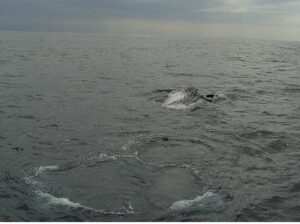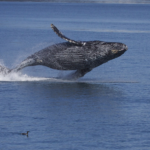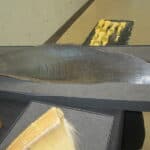Krill are crustaceans that play an important role in the ecosystem since they are the primary food source for many large marine mammals. First, however, it’s worth noting whether whales eat krill.
Whales eat krill, but not all of them. Nevertheless, these tiny shrimp-like invertebrates are abundant beneath the ocean’s surface and provide a significant portion of the nutrition for these massive creatures.
The fact that krill are available all over the planet is one of the key reasons why they are so vital to whales and other larger marine species. Because whales spend so much of their time on the move, they seek out food found in practically every ocean, and krill is one of their favorites.
This post is dedicated to determining whether whales consume krill and, if so, how and why they do so. We’ll also look into some related information to the main topic.

Do all whales eat krill?
The eating habit of whales is diverse. Much similar to their cosmopolitan habitat, their eating preference also changes based on their species, environment, etc.
Although krill are an essential food source for most whales, they are not eaten by all of them. That said, there are two types of whales- toothed and baleen, and it is the second type that feeds on krill and planktons.
These whales are called filter feeders, as they do not bite but draw in their food through the baleens.
Do baleen whales eat krill?

There are two main categories of whales- toothed and baleen. Baleen whales are larger, and they do not possess any teeth.
Baleen whales primarily feed on krill. They swim with their mouths open to accomplish this. Consequently, water, along with planktons, krill, and crustaceans, enter their mouth. They filter the water out and absorb the food.
Among baleen whales, humpback whales, blue whales, and gray whales, among others, essentially feed on krill.
Why do whales eat krill?
Whales are among the massive creatures on earth. So the common question that might arise is, despite being so huge, why do they feed on extremely tiny krill?
Baleen whales feed on krill for various reasons, one of which is quantity. Whales are migratory species that require food that is always available. Krill can be found in all waters around the world. So, they enjoy eating them. Furthermore, krill-eating whales have baleen instead of teeth, making it necessary to absorb rather than bite their prey.
Whales eat lots of krill and plankton every day to keep their weight up. The whales usually swim through the buzz of krill with their mouths wide, attempting to swallow as many krill as feasible in a single pass.
How many krill do whales eat?
Baleen whales are a big fan of krill. They eat tons of these every day to sustain themselves. So, how much krill do they need to eat in a single day?
As per approximate estimation, a large whale can gobble up to 4 tons of krill every single day. Below is a list stating the amount of krill three major species of baleen whales can eat (in a day):
- Blue whale- 8,000 lbs
- Gray whale- 2,400 lbs
- Humpback whale- up to 5500 lbs
According to a recent study, Baleen whales can swallow more krill than previously assumed. Baleen whales such as the blue whale, fin whale, and humpback whale may ingest krill around 5 to 30% of their total body weight, according to a study conducted by Matthew Savoca at Stanford University, CA.
Do blue whales eat krill?

Blue whales are enormous. They are the world’s largest living creatures. So, what do these colossi eat to stay alive?
Blue whales, a baleen whale species, eat virtually solely krill. These migratory whales can be found in all oceans except the Arctic Ocean. They can subsist on the plentiful food source because they eat krill.
Blue whales draw in a lot of water and plankton with their mouth. They then use their baleen plates to force the water out and strain the meal.
It’s worth noting that baby blue whales don’t ingest krill throughout their first 6–18 months of life. Baby whales are completely reliant on their mother’s milk for the first year of their life. They will continue to survive only on milk until they learn how to hunt.
How much krill do blue whales eat a day?
Because blue whales are so massive, they have a big appetite. This raises the question of how much krill they consume per day. Let’s have a look.
A blue whale’s principal food source is krill, which may consume up to 4 tons in a single day. Some of the largest species have been known to consume up to 6 tonnes of krill every day.
Thanks to their filter-feeding mechanism, these creatures swim toward swarms of krill with their mouths open, swallowing both their meal and the surrounding water.
Why do blue whales eat krill?
Despite being the world’s largest animal, why do blue whales eat krill instead of larger species? Let’s have a look.
One of the primary reasons is that blue whales have baleen, making them filter feeders. They don’t possess teeth, so they can’t bite their prey. They are only able to eat by filter-feeding. Furthermore, krills are abundant throughout the world’s waters, making it simple for blue whales to consume them.
Krill often swim in huge groups, making it easier for blue whales to swallow them all at once.
Do blue whales only eat krill?
Whales have different food habits. Not all of them eat similar whale food. So do blue whales eat only krill?
Blue whales feed almost exclusively on krill or euphausiids.
The feeding structure of these animals has evolved in such a way that they can capture these tiny creatures and absorb a lot of them at once.
What do blue whales eat besides krill?
Filter feeders, blue whales are. They eat crustaceans and small fish. But, aside from krill, do they have any other dietary sources?
It is quite rare for a blue whale to eat anything other than krill. They favor crustaceans such as zooplankton, amphipods, and pelagic red crabs, even if they divert from krill.
Do killer whales eat krill?
Killer whales are members of the toothed whale family. They attack and rip the flesh of the target with their teeth.
Killer whales do not eat krill because they hunt with their teeth. Instead, this dolphin species prefers to eat larger prey such as seals, turtles, and even great white sharks.
Killer whales, often known as orcas, are classified as apex predators, meaning they are at the top of the food chain. Whales that feed krill and planktons are at the bottom of the food chain, whereas killer whales are at the top.
Do beluga whales eat krill?
Beluga whales have one of the most unusual appearances of any whale species. They lack the baleen plate and are toothed whales.
Because they are toothed, beluga whales do not eat krill. However, like sharks, these whales are opportunistic feeders, which means their diet varies depending on region and season.
Arctic cod, Greenland halibut, crabs, clams, octopus, sea snails, and other aquatic creatures are beluga whales’ preferred diets.
Do humpback whales eat krill?
Humpback whales are counted as one of the largest whale species on earth. These whales are species of baleen whales.
Humpback whales possess baleen instead of teeth and primarily feed on krill and schools of smaller fishes.
Do gray whales eat krill?
Gray whales are different species of baleen whales. They filter feed and have the rough baleen among all whales.
Krill is a food source for grey whales. Bottom feeders, these whales receive their food by dragging the side of their heads all along the ocean bottom and picking up material. Although these whales eat krill, amphipod crustaceans and worms are their primary meal.
Summary
This leads us to the conclusion of this piece. Finally, we may deduce that practically all baleen whales prefer krill as a food source. Nonetheless, some of the species prefer to eat worms as well. Furthermore, these organisms’ baleen plates allow them to draw in water and plankton, straining the latter inside. Lastly, we hope you enjoyed this article and have gained knowledge from it.




